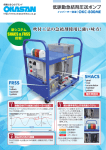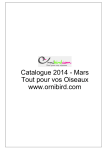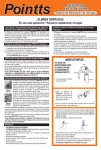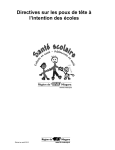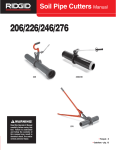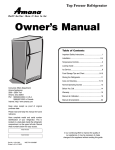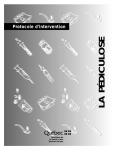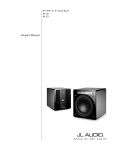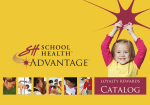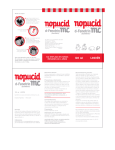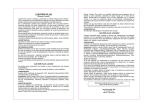Download What are lice?
Transcript
AISD Lice Prevention, Control, and Treatment Protocol Updated, 2010 Based on recommendations from the American Academy of Pediatrics (AAP), 2010, Austin ISD has updated its’ Lice Prevention, Control, and Treatment Protocol to reflect the most current guidelines in the control of lice. Head lice are common for children ages 3-12. Head lice are not a health hazard and are not responsible for the spread of any disease. They are the cause of much embarrassment, misunderstanding, and many unnecessary days lost from work and school. “No-nit” policies which keep kids with lice home as long as they have any evidence of an infestation don’t benefit these kids or their classmates and “should be abandoned” (American Academy of Pediatrics, 2010). Historically, in an effort to decrease head lice infestations, many US schools adopted “no nit” policies. Subsequently, schools report extended student absences. Reports found that 12 to 24 million school days are lost annually due to exclusion of students with nits. Presence of nits does not indicate active infestation and no evidence have been found that the presence of nits correlates with any disease process (National Association of School Nurses, 2004). “No nit” policies that require a child to be free of nits before they can return to school are not recommended (Centers for Disease Control, 2007). Texas Department of State Health Services is not alone in their stance against strict “no-nit” policies. A panel of scientist and public health officials convened at the Harvard School of Public Health to discuss these issues. In regards to “nonit” policies, the report shows that there is little evidence that exclusion from school reduces the transmission of head lice (Texas Department of State Health Human Services, 2007). The goal of lice prevention, control, and treatment in schools is to prevent the spread of lice from one student to another student. Lice control takes teamwork among home, school, after-school programs, and events in private or public locations, including student visits in each other's homes. Live Lice and Nit Prevention, Control, and Treatment Protocol Initial Identification of Infestation Cases of lice should be confirmed by the RN, School Health Assistant or trained AISD staff. Live Lice • All students identified with live lice will be sent home at the end of the school day after contacting parent/guardian by phone. Parents/Guardians will be advised to treat their child for head lice. The name of the treatment product must be provided by the parent/guardian on the treatment letter. (See Resource Section) After treatment has been completed, the student can return to school. • Educational materials about treatment and prevention should be given and explained to parent/guardian. • Based on the AAP, 2010 recommendations, alert letters will only be sent home in the event of a high percentage of students infested in a classroom. There is no need to send home alert letters for “2 or more students” infested as this may cause unnecessary public alarm. Nits • Students identified with nits only will have their parent/guardian contacted to see if treatment has taken place within the last seven days. The name of the treatment product must be provided by the parent/guardian on the treatment letter. (See Resource Section) • If treatment has occurred within the last week, the student may stay in school. Educational material about nit removal and prevention of lice should be provided to parent/guardian. • If treatment has not occurred in the last seven days, the student should be sent home at the end of the day for treatment and removal of lice (AAP, 2010). Educational materials about treatment and prevention of lice should be provided and explained to parent/guardian. Once treatment has been completed, the student can return to school. Requirements for Readmission to School • Student must bring proof of treatment or a statement verifying treatment signed by parent/guardian. • If the student has been treated and provides proof of treatment the student may be readmitted to school • If live lice are found at re-check, the RN should be contacted to assess the adequacy of treatment and counsel the family before sending the student home. The student may remain in school unless otherwise recommended by the health team. Treatment Failures and Frequent Re-infestations • If live lice are found following treatment, the RN should be notified. She will investigate and make further recommendations to the family. Classroom Control Measures: • The Health Team will provide teachers with the "Checklist for Classroom Lice Control." Contact the RN for any questions regarding classroom lice control. • Teachers are expected to follow the guidelines to prevent the spread of lice. • At all times, schools are encouraged to discontinue fabric-covered items, i.e., pillows, blankets used by more than one child. Teachers may request storage bags to separate all coats/sweaters. Teachers, Assistants, and Monitors should not allow piling of coats. Responsibilities Student Health Services • Screening students sent to health room displaying symptoms • Screening will be done on an individual basis for students reporting or demonstrating symptoms (ie. lice visible in hair, scratching scalp). Current evidence does not support the efficacy and cost effectiveness of classroom or school wide screening for decreasing the incidence of head lice among school children (Centers for Disease Control, 2007) (American Academy of Pediatrics, 2010) • The health team has educational materials about lice available in the health room for students, staff and parents. The RN will submit newsletter articles to educate parents and staff regarding lice. • The RN will provide health teaching to students, staff, and parents regarding prevention, detection and treatment of lice as needed. Quick Care/AISD staff • All staff members should be familiar with the signs and symptoms of lice infestation. Detection of lice or nits, or suspicion of lice or nits, should be promptly reported to the Health Team or designated, trained office staff. • If the RN or School Health Assistant is not on campus, the quick care/AISD staff will screen students sent by the teacher suspected of having lice. Teaching Staff • Survey the classroom environment regularly for students displaying signs of lice or items in the classroom that could be contributing to the spread of lice. • Implement the “Checklist for Classroom Lice Control” and make appropriate changes. (See Appendix for Checklist). • Send students to health room for inspection by the School Health Assistant or RN if lice visible in hair or scratching scalp. Parent/Guardian • Parents/Guardians need to make lice screening a part of their family routine. Parents should check their children’s head at least weekly. • Parents/Guardians should follow the recommendations and/or treatment guidelines from Student Health Services. Community Education and Cooperation • The lice prevention, control, and treatment protocol will be shared with AISD staff and staff of after-school programs for implementation in these programs, thus allowing for consistency when children are in school environments. • The lice prevention, control, and treatment protocol and educational information may be shared as requested with Austin's private or parochial schools and with major after-school organizations, i.e., athletic or recreational facilities. • Educational materials such as video tapes, books and posters are available from Children's/AISD Student Health Services Administrative Office at Dell Children’s Medical Center and may be checked out to RNs for parents, teachers, or group education. Lice Resource/Parent Letter Section Screening Procedure 1. The RN, School Health Assistant and trained AISD Quick Care staff will be responsible for screening. Classroom teachers are responsible for classroom surveillance. 2. Provide as much privacy as possible. Do NOT indicate that a student has lice/nits in the presence of the other students. 3. Use two objects long enough to separate the hair and expose the scalp. Nonsterile cotton-tipped applicators, coffee stir sticks, etc. can be used. 4. Check the back of the head and around the ears. If the hair is short in the back, check the area of the head where the hair is longer. If the child is itching, check the entire head. 5. Separate the hair and look for nits and moving lice. Nits will not move when the strand of hair is flicked. Dandruff, hair casts, lint and other debris will move when the strand of hair is flicked. Dispose of cotton tipped applicators or coffee stir sticks after one use. 6. Wash hands or change gloves. General Information What are Lice? Infestation by head lice, also known as pediculiosis capitis is a common problem that crosses all geographic and socioeconomic boundaries in this country. Lice depend on their hosts for food (blood) and warmth. Lice are found specifically on the scalp because this area is warm and dark. Lice cannot live long separated from this source of food and warmth. The adult head louse is a wingless insect about 2.1 to 3.3 mm, about the size of a sesame seed. The living insects can be difficult to see because they run quickly from the light. Females lay 6-10 eggs per day that are incrusted in pearly white egg-cases called nits. Live nits are usually found 1/4th inch or less from the scalp where they are fixed firmly to the hair shaft with a glue like substance that makes them difficult to remove. This characteristic helps distinguishing nits from other hair debris like dirt and dandruff. After 5-10 days the nits hatch to produce juvenile lice called nymphs. The nymphs mature fully, able to lay eggs in about two weeks. The entire cycle takes about 21 days. Treatment Options Currently there are four different compounds commercially available in the U.S. for treatment of lice infestation. All pediculicides (chemical formulation that kill lice) work by interfering with the nervous system of the louse. The first two are available over the counter without a prescription: Pyrethrin (RID, A200 etc.) and permethrin (NIX creme rinse). However, a prescription is required if the cost is to be covered by Medicaid. The others, Lindane (Kwell) and Malathion (Ovide) is available only by prescription. They require a prescription because they have a higher rate of neurological toxicity. For resistant cases of pediculosis, prescription Elimite 5% topically to scalp or Bactrim by mouth has been used. All of these pediculicides should be used externally and directions should be followed very carefully. Frequent treatment application is discouraged unless medical assessment has been made as to why re-infestation is occurring. Olive oil and mayonnaise have also been used effectively as an adjunct treatment to treat lice. The method of action is thought to be suffocation of the lice. Therefore, to be effective the oil or mayonnaise must remain on scalp for more than four hours at a time and repeated every 4 days for 3 weeks. Checklist for Classroom Lice Control ________ Play items (hats, wigs, dress up clothes, etc.) cleaned after each child’s use ________Sweaters, backpacks, and coats hung separately on hooks and not touching. Sweaters, coats, and hats can often be placed in each student’s backpack ________Children’s personal items (combs, brushes, hats, scarves, sweaters, coats etc.) are not shared ________ Carpet is vacuumed daily ________ No sharing of cloth or upholstered pillows, mats, etc. ________ Nap items (pillows, blankets, towels, etc.) are stored separately in a cubby or plastic bag and taken home at least weekly to be washed. ________ Headphones are wiped with disinfectant after each child’s use ________ Observation of children for: • Nits/lice in hair (on nape of neck, over ears, and within inch of scalp) • Scratching of head and neck INSTRUCTIONS FOR TREATMENT AND CONTROL OF HEAD LICE AND NITS Use a pediculicide lice shampoo such as Rid (non-prescription), or R&C (non-prescription). You might want to ask your doctor or pharmacist for recommendations. Follow directions on the bottle exactly. Nix, a nonprescription lotion is also effective and does not require a second treatment. Do NOT use flea shampoo or gasoline. These are very dangerous and not proven to be effective. Repeat pediculicide (lice) shampoo treatment of the hair in 7 to 10 days (depending upon the pediculicide used) to assure that if any nits have hatched, the new lice will be killed before they can lay more eggs. Comb out the nits: Using a good metal nit comb, comb the hair section by section. Clean environment: To address this problem household cleaning should be done on the same day as the child’s treatment. Soak combs and brushes for one hour in a pediculicide lice shampoo or five to ten minutes in hot water (130°). Change into freshly washed clothes after treatment. Change and wash all sheets, pillowcases, and blankets in hot water and machine dry on hot setting. Wash all previously worn clothes, coats and hats. Vacuum rugs, carpets and upholstered furniture, including the upholstery in the car. Pillows, stuffed animals or non-washable items must be either dry cleaned, washed, sealed in a plastic bag for 7 days or placed in a dryer for 20 minutes of hot air. INSTRUCTIONS FOR MAYONNAISE TREATMENT Olive oil or mayonnaise treatment: Olive oil or mayonnaise may be helpful as an additional treatment following the use of a lice shampoo because it smothers and kills active head lice Cover the entire scalp and hair with olive oil or real mayonnaise (do not use low fat or mayonnaise substitute). Then cover the head with plastic wrap or shower cap. Leave the olive oil or mayonnaise on at least 4 hours or overnight. Repeat treatment every 4 days for three weeks. This is to coincide with the life cycle of the louse. If you choose not to use a pediculicide lice shampoo, use the olive oil or mayonnaise treatment for 2 days in a row in addition to all other designated days. Leave the olive oil or mayonnaise in the hair for the nit removal. Helpful Hints for Nit Removal Removing nits is the most important step in preventing the recurrence of head lice. For the initial treatment, use a pediculicide shampoo or treatment to kill the live lice and then: Comb the hair with a regular comb if the hair is thick and/or long to remove the tangles. Comb the hair into one-inch sections and remove the nits in each section by using a metal nit or flea comb. A metal nit comb can be reused if washed and boiled. Remove remaining nits by hand if necessary. Remember the key to successful lice treatment is complete removal of ALL nits. To aid in the removal of nits you may want to apply olive oil and let it set 4 hours, making the nits easier to remove. Other over the counter products that you may buy for nit removal are Clear, Step 1, and mayonnaise. Helpful Hints for Cleaning the Environment Soak combs and brushes for one hour in a pediculicide lice shampoo or five to ten minutes in hot water (130°). Change into freshly washed clothes after treatment. Change and wash all sheets, pillowcases, and blankets in hot water and machine dry on hot setting. Wash all previously worn clothes, coats and hats. Vacuum rugs, carpets and upholstered furniture, including the upholstery in the car. Pillows, stuffed animals or non-washable items must be either dry cleaned, washed, sealed in a plastic bag for 7 days or placed in a dryer for 20 minutes of hot air. Sugerencias útiles para quitar las liendres Quitar las liendres es el paso más importante para prevenir la recurrencia de piojos en la cabeza. Para el tratamiento inicial, use un shampú pediculicida o tratamiento para matar las liendres y después: Peine el cabello con un peine regular si el cabello es grueso o largo, para desenredarlo. Peine el cabello en secciones de una pulgada y quite las liendres en cada sección usando un peine de metal para liendres o pulgas. Puede volver a usar un peine de metal si lo lava y hierve. Si es necesario, quite con los dedos las liendres que queden. Recuerde que para el tratamiento para liendres tendrá éxito si quita completamente TODAS las liendres. Para ayudar a quitar las liendres puede usar aceite de oliva y dejarlo reposar en el cabello por 4 horas, lo que hará más fácil quitarlas. Otros productos que puede comprar para quitar liendres sin receta médica son Clear, Step 1, mayonesa y una solución de vinagre y agua (una ración de vinagre por una de agua). Sugerencias útiles para limpiar su entorno Remojar cepillos y peines por una hora en un shampú pediculicida para piojos, o de cinco a diez minutos en agua caliente (130°). Después del tratamiento, ponerse ropa limpia. Cambiar y lavar todas las sábanas, fundas y colchas en agua caliente y secarlas en la secadora a temperatura caliente. Lavar toda la ropa, abrigos y sombreros que hayan sido usados. Aspirar alfombras, tapetes, incluyendo la tapiceria del auto. Almohadas, animals de peluche o artículos que no se pueden lavar deben lavarse en seco, lavarse con agua y jabón, ponerse en una bolsa de plástico herméticamente cerrada por 7 días o colocarlos en la secadora de ropa por 20 minutos en aire caliente. CHILDREN’S/AISD STUDENT HEALTH SERVICES Teacher/Grade: _____________________________/_______________ DATE: __________________________ RE: HEAD LICE Dear Parent/Guardian: Your child, _______________________________________, has signs and symptoms of head lice. Even though they do not jump or fly, they can be spread from one person to another by sharing combs, brushes, clothing and hats. Head lice can happen to anyone. It is not a sign of poor health habits or being dirty. To control the spread of head lice, your child may not return to school until after he/she has been treated. It is recommended that all household members be checked and treated the same day. The student will be checked for lice and upon returning to school by the health team or school office staff. Please have your child report to the office before going to class. Working together we can meet this challenge. I am available to discuss any questions you might have concerning this matter. _____________________________ School Nurse __________________________ Telephone Number The following information is required before your student can re-enter the class room. Please complete and have your child take it to the health office when she/he returns to school. _____________________________ Child’s Name ___________________________ Date of Treatment _____________________________ Parent’s Signature ____________________________ Name of Treatment/Shampoo/Rinse CHILDREN’S/AISD STUDENT HEALTH SERVICES TO: Parents of _______________________class FROM: Children's/AISD Student Health Services SUBJECT: HEAD LICE IN THE CLASSROOM FOR YOUR INFORMATION: There was a case of head lice reported in your child’s class today. We are sending you this letter to inform you of head lice and to encourage you to check your child this evening and at least once a week, so we can keep the situation under control. Head lice are parasitic insects which live on the scalp. The signs and symptoms of head lice are: a. Persistent itching and scratching of the scalp. b. Live lice are white and about 1/16 inch long. c. The lice eggs are called nits and are shiny grayish, unlike dandruff they do not come off easily. NOTE: Nits are shiny, grayish and look like dandruff, but won’t flick off. Head lice do not hop, jump, or fly. They crawl from one person to another by direct contact and by use of infested articles. To control and avoid lice: a. b. c. d. Do not share hats, coats, headgear, combs or brushes. Inspect hair weekly for presence of lice and nits. Notify your child’s school, day care center, or nursery if you find lice/nits. Treat promptly if you find lice/nits. Children with head lice are not allowed to return to school until they have received the recommended treatment and have been cleared by the school staff or the health team. It is important to notify the school if you find that your child has an active case and has received treatment. ____________________________ School Nurse _______________________________________ Telephone Number ****If you identify lice on your child, please complete information below.**** ________________________________________________________________________ The following information is required before your student can re-enter the class room. Please complete and have your child take it to the health office when she/he returns to school. _____________________________ Child’s Name ___________________________ Date of Treatment _____________________________ Parent’s Signature ____________________________ Name of Treatment/Shampoo/Rinse CHILDREN’S/AISD STUDENT HEALTH SERVICES Teacher/Grade: _____________________________/_______________ DATE: __________________________ RE: NITS Dear Parent/Guardian: Your child____________________________________ has nits in his/her hair. Removing nits is the most important step in preventing the recurrence of head lice. The ‘Helpful Hints’ attached to this letter may be useful to you in getting the nits out. Working together we can meet this challenge. I am available to discuss any questions you might have concerning this matter. Sincerely, ______________________________ School Nurse _______ _________________________________ Telephone Number My child has received treatment for lice in the past 7 days. _______________________________________________________ Name of Treatment/Shampoo/Rinse / Date of Treatment _______ It has been longer than 7 days since my child has received treatment for lice. References for change in policy: Center for Disease Control Division of Parasitic Diseases (DPD) National Center for Zoonotic, Vector-Borne, and Enteric Diseases (ZVED) Information for Schools, Information for Parents Content Source: Page last reviewed: May 16, 2007 National Association of School Nurses Policy Statement Nit Free Policies in the Management of Pediculosis: Adopted: November 1999 Revised: July 2004 American Academy of Pediatrics Clinical Report-Head Lice PEDIATRICS July 26, 2010 Immunizations & Infectious Diseases: An Informed Parent's Guide Copyright © 2006 Last Updated 6/15/2010 Head Lice PEDIATRICS Vol. 110 No. 3 September 2002, pp. 638-643 A statement of re-affirmation for this policy was published on May 1, 2009 Pediculosis Capitis (Head Lice) Red Book.; 2009: 495-497 Committee on School Health and Committee on Infectious Diseases Barbara L. Frankowski, Leonard B. Weiner, Pediatrics 2002;110;638-643 Lice, Nits, and School Policy PEDIATRICS Vol. 107 No. 5 May 2001, pp. 1011-1015 TEXAS DEPARTMENT OF STATE HEALTH SERVICES RECOMMENDATIONS ON “NO-NIT” POLICIES IN SCHOOLS, September 2007 Head Lice Fact Sheet — No.1 What are lice? 1. Lice, or Pediculosis (pe·dic·u·lo·sis), are small tan to grayish-white insects, about the size of a sesame seed and have six legs. 2. They don’t usually carry disease, but can cause your child and family discomfort, stress and sometimes skin irritation. 3. Lice can live up to 30 days on a person’s head and lay from 50 to 150 eggs. To live, adult lice need to feed on blood every 3 to 6 hours. If the louse falls off a person, it dies within 2 days. 4. There are three types of lice: head, body and crab lice. Body lice haven’t been reported in Texas for years. Head lice and crab lice are common but not usually found at the same time on a person. Here’s where they can hide: • Head lice live on the head and rarely leave the body. • Body lice live in the seams and linings of clothing, blankets and sheets and move to the body when feeding. • Crab lice live on the hairy portions of the body. They like the pubic and anal areas; but, only on adults. Adults who have pubic lice should be examined for sexually transmitted diseases (STDs). Even though crab lice and STDs aren’t related, both conditions may be present at the same time. Children rarely get crab lice. However, if a child has it, you may want to suggest an examination for possible signs of inappropriate contact. For more information contact the Department of State Health Services, School Health Program at www.dshs.state.tx.us/schoolhealth/lice.shtm or call 512-458-7279 DSHS publication no. E05-12864 Hoja informativa sobre los piojos de la cabeza — N.O 1 ¿Qué son los piojos? 1. Los piojos, también conocidos como pediculosis (pe-di-cu-lo-sis), son insectos pequeños entre color habano y blanco grisáceo, casi del tamaño de una semilla de ajonjolí, con seis patas. 2. Por lo general no son portadores de enfermedades pero pueden causar a su hijo y a su familia molestia, estrés y a veces irritación de la piel. 3. Los piojos pueden vivir hasta 30 días en la cabeza de una persona y ponen de 50 a 150 huevos. Para vivir, los piojos adultos necesitan alimentarse de sangre cada 3 a 6 horas. Si el piojo se cae de la persona, muere en los 2 días siguientes. 4. Hay tres tipos de piojos: los piojos de la cabeza, los del cuerpo y los del pubis. No se ha informado de piojos del cuerpo en Texas en años. Los piojos de la cabeza y los piojos del pubis son comunes pero por lo general no se encuentran en la misma persona al mismo tiempo. Se pueden esconder en los siguientes lugares: • Los piojos de la cabeza viven en la cabeza y raramente se van del cuerpo. • Los piojos del cuerpo viven en las bastillas y el forro de la ropa, las cobijas y las sábanas y se van al cuerpo cuando se alimentan. • Los piojos del pubis viven en las partes velludas del cuerpo. Les gusta el área púbica y anal pero sólo en los adultos. Se debe examinar a los adultos que tengan piojos del pubis por si tuvieran enfermedades venéreas. No obstante los piojos del pubis y las enfermedades venéreas no están relacionados, ambas enfermedades podrían estar presentes al mismo tiempo. Los niños rara vez tienen piojos del pubis. Sin embargo, si un niño los tiene, quizá quiera sugerir que lo examinen para ver si tiene signos de contacto inapropiado. Para informarse al respecto comuníquese con el Programa de Salud Escolar del Departamento Estatal de Servicios de Salud de Texas en www.dshs.state.tx.us/schoolhealth/lice.shtm o llame al 512-458-7279. Head Lice Fact Sheet — No.2 How do I know if my child has head lice and if so, how did they get it? 1. Itching is the first sign of head lice, unless your child has a very light case. Check your child’s head and scalp all over and especially behind the ears and near the neckline at the back of the neck when scratching begins. 2. Look for lice and their eggs or “nits.” (See Fact Sheet #3 to find out about nits.) You may see the nits before you find a louse because each louse can lay up to 150 at a time. 3. You may first find lice or nits on the hairs at the “nape” of the neck (back of the head where the hair stops and the neck begins) and behind the ears. But, they can live anywhere; so, look all over the scalp. 4. If you know of another child with head lice, be alert that your child may contract lice, too. There is no incubation period. When live lice move from one child’s head to another; they are “home” and can begin laying eggs immediately. 5. Children get head lice almost as much as the common cold. Millions get it at least one time, once a year. 6. Children get lice from other children. They move from child to child through head to head contact. 7. Lice cannot hop, jump or fly but can crawl from child to child anytime children are close together; during play or sports or even nap time. 8. Sharing combs, brushes, hair fasteners, hats, caps, coats, neck scarves and even head phones spreads them, too. Sharing a locker or cubbyhole with a liceinfested child is a common way to spread lice. If left behind, lice can attach to your child while sitting on carpets or furniture. Lice can even attach to stuffed toys. 9. Children get lice more than teens or adults. ANY child can get head lice! It doesn’t matter where they live or go to school; how much money they have; or, if boy or girl, black, white or brown. 10. A child isn’t sick or unclean if they have head lice. Taking baths won’t kill lice or keep children from getting lice. And, if a child has head lice, it certainly doesn’t mean they have bad parents. 11. Dealing with lice is difficult, sometimes embarrassing and can be overwhelming to anyone caring for children. See Fact Sheet #3 for how to get rid of lice. DSHS publication no. E05-12865 For more information contact the Department of State Health Services, School Health Program at www.dshs.state.tx.us/schoolhealth/lice.shtm or call 512-458-7279 Hoja informativa sobre los piojos de la cabeza — N.O 2 ¿Cómo sé si mi hijo tiene piojos en la cabeza? Y, de ser así, ¿cómo se le pegaron? 1. La comezón es el primer signo de piojos en la cabeza, a menos que su hijo tenga un caso muy leve. Revísele toda la cabeza y el cuero cabelludo a su hijo especialmente detrás de las orejas y en la nuca cuando empiece a rascarse. 2. Fíjese si tiene piojos y sus huevos o liendres. (Vea la hoja informativa n.o 3 para informarse sobre las liendres). Es posible que vea liendres antes de que encuentre un piojo porque cada piojo puede tener hasta 150 a la vez. 3. Podría primero encontrar piojos o liendres en el cabello de la “nuca” (la parte trasera de la cabeza donde termina el cabello y empieza el cuello) y detrás de las orejas. Pero, pueden vivir en cualquier parte; así que fíjese en todo el cuero cabelludo. 4. Si sabe de algún otro niño que tenga piojos en la cabeza, esté alerta porque a su hijo se le podrían pegar los piojos también. No existe periodo de incubación. Cuando los piojos vivos se van de la cabeza de un niño a la de otro, se sienten como en casa y pueden empezar a poner huevos inmediatamente. 5. A los niños les salen piojos casi tanto como les da el catarro común. Le salen a millones al menos una vez al año. 6. A los niños se les pegan los piojos de otros niños. Se van de un niño a otro mediante el contacto de sus cabezas. 7. Los piojos no pueden saltar, brincar ni volar pero pueden subirse de un niño a otro en cualquier momento que los niños estén juntos cerca; cuando jueguen o hagan deporte y hasta cuando tomen la siesta. 8. Compartir peines, cepillos, cosas para agarrarse el pelo, gorros, gorras, abrigos, bufandas y hasta auriculares los propagan también. Compartir un locker o un compartimiento reducido con un niño infestado con piojos es una forma común en que los piojos se propagan. Si alguien deja piojos en las alfombras y los muebles, los piojos se le pueden pegar a su hijo estando sentado en ellos. Los piojos hasta se pueden subir a los peluches. 9. A los niños les salen piojos más que a los adolescentes o adultos. ¡A TODOS los niños les pueden salir piojos en la cabeza! No importa dónde vivan o vayan a la escuela; cuánto dinero tengan o si son niños o niñas, negros o blancos o morenos. 10. Un niño no está enfermo ni sucio si tiene piojos en la cabeza. Bañarse no mata a los piojos ni evita que le salgan a los niños. Y, desde luego, que un niño tenga piojos en la cabeza no significa que sus padres sean malos. 11. Es difícil lidiar con los piojos y a veces causa vergüenza y puede ser abrumante para cualquier persona que cuide niños. Vea la hoja informativa n.o 3 para informarse sobre cómo deshacerse de los piojos. Para informarse al respecto comuníquese con el Programa de Salud Escolar del Departamento Estatal de Servicios de Salud de Texas en www.dshs.state.tx.us/schoolhealth/lice.shtm o llame al 512-458-7279. Head Lice Fact Sheet — No.3 What should I do if I think my child has head lice? 1. You can take care of your child’s head lice problem at home without a visit to the doctor or clinic. Treatment should be with shampoo or cream rinse approved by the FDA that can be purchased without a prescription at the drug store, grocery store or other places that carry drug store products. 2. Many parents feel embarrassed when their child has lice. Sometimes it helps to talk to someone who can offer extra help. The nurse at your child’s school, your physician and even the pharmacist can help. Neighborhood, city or county health clinics may provide trained, helpful professionals. Contact your area Department of State Health Services public health region for suggestions. See Fact Sheet #6 for Regional offices or go to www.dshs.state.tx.us/regions/default.shtm for the listing. 3. After the first treatment, you may not see live lice but you might see nits. If the nits (or lice eggs) are attached to strands of hair ¼ inch or less from the scalp, they are probably not dead. This means live lice could still be living somewhere on your child’s head; or, soon will hatch from the remaining eggs. 4. That’s why, after treatment, it is important to comb out the nits left in your child’s hair with a special nit comb available to pick up where you buy lice treatment. 5. Nits are very tiny; about the size of a knot in a thread. They are shaped like a long football, yellow to white in color and are often mistaken for dandruff or hair spray droplets. They attach to a hair at the scalp with a waterproof, cement-like substance. That’s why they can be difficult to remove. 6. You may find nits first on the hairs at the “nape” of the neck (back of the head where the hair stops and the neck begins) and behind the ears. But, they can live anywhere; so, look all over the scalp. 7. A second treatment and then a second combing are necessary. Even after thoroughly using the nit comb, live lice or nits could still be hiding somewhere on your child’s head. All products specifically created to treat head lice will recommend a second treatment anywhere from 7 to 10 days after the first treatment in order to kill any remaining or newly hatched lice. DSHS publication no. E05-12866 For more information contact the Department of State Health Services, School Health Program at www.dshs.state.tx.us/schoolhealth/lice.shtm or call 512-458-7279 Hoja informativa sobre los piojos de la cabeza — N.O 3 ¿Qué debo hacer si creo que mi hijo tiene piojos en la cabeza? 1. Puede resolver el problema de los piojos de la cabeza de su hijo en casa sin ir a consulta con el doctor o a una clínica. El tratamiento debe ser con un champú o una crema de enjuague aprobada por la FDA que se pueda comprar sin receta en tiendas con farmacias, en tiendas de abarrotes u otros lugares que tengan productos de farmacia. 2. Muchos padres sienten vergüenza cuando su hijo tiene piojos. A veces ayuda hablar con alguien que pueda ofrecer ayuda extra. La enfermera de la escuela de su hijo, su médico y hasta su farmacéutico pueden ayudar. Las clínicas de salud del vecindario, la ciudad o el condado podrían proveer profesionales capacitados útiles. Comuníquese con la región de salud pública del Departamento Estatal de Servicios de Salud de Texas de su área para que le den sugerencias. Vea la hoja informativa n.o 6 para encontrar las oficinas regionales o vaya a www.dshs.state.tx.us/regions/default.shtm donde encontrará el listado. 3. Tras el primer tratamiento, podría no ver piojos vivos pero podría ver liendres. Si las liendres (o los huevos de los piojos) están pegadas al cabello a ¼ de pulgada o menos del cuero cabelludo, probablemente no estén muertas. Eso significa que podría todavía haber piojos vivos viviendo en algún lugar de la cabeza de su hijo o que pronto saldrán de los huevos que quedan. 4. Es por eso que, tras el tratamiento, es importante que quite las liendres que queden en el cabello de su hijo con un peine para liendres especial disponible donde compre el tratamiento para los piojos. 5. Las liendres son muy pequeñas; son casi del tamaño de un nudo en un hilo. Tienen forma de pelota de fútbol americano larga, son entre amarillas y blancas y a menudo se las confunde con caspa o gotas de fijador para el cabello. Se pegan al cabello en el cuero cabelludo con una sustancia impermeable que parece cemento. Es por eso que puede ser difícil removerlas. 6. Podría primero encontrar liendres en el cabello de la nuca (la parte trasera de la cabeza donde termina el cabello y empieza el cuello) y detrás de las orejas. Pero pueden vivir en cualquier parte; así que revise todo el cuero cabelludo. 7. Es necesario un segundo tratamiento seguido de un segundo pase del peine. Aun después de usar el peine para las liendres rigurosamente, todavía podría haber piojos o liendres vivas escondidas en algún lugar de la cabeza de su hijo. Todos los productos creados específicamente para tratar los piojos de la cabeza recomiendan un segundo tratamiento 7 a 10 días después del primer tratamiento para matar las liendres restantes o las que acaban de salir del huevo. Para informarse al respecto comuníquese con el Programa de Salud Escolar del Departamento Estatal de Servicios de Salud de Texas en www.dshs.state.tx.us/schoolhealth/lice.shtm o llame al 512-458-7279. Head Lice Fact Sheet — No. 4 How do I keep lice from coming back? 1. Carefully follow the directions on the lice treatment package. Not following directions, is the biggest reason why it doesn’t work. 2. If your child has extra long hair (longer than shoulder length), you may need to use a second bottle. Pay special attention to instructions on the bottle about how to thoroughly work it into the hair, how long the medication should be left on and whether rinsing the hair is recommended after treatment. 3. Comb out the nits left after treatments. (See Fact Sheet #3 to learn about nits.) Do this by sliding a nit up the hair shaft with your fingers or using a nit comb. Special nit combs are available in the store where you bought the lice treatment. 4. Most of the time a second treatment is necessary. If you don’t kill the nits, they will hatch and your child will have lice again – this time without any contact with another infested child! All products specifically created to treat head lice will recommended a second treatment and a second nit combing, anywhere from 7 to 10 days after the first treatment to kill any left over lice and nits. 5. Launder clothing and bedding immediately before lice treatment on your child so any live lice living there can’t crawl onto licefree, just treated heads! • Laundry water should be at least 130 degrees Fahrenheit to kill the lice. • CAUTION: Do not bathe or shampoo in water this hot! This temperature is for laundry only! 6. Dry cleaning kills lice and their nits in clothing that can’t be washed. DSHS publication no. E05-12867 7. Sealing clothing, stuffed toys, pillows, blankets or other small soft items, for two weeks in tightly closed plastic bags will kill both lice and nits! It’s low cost, too. 8. Safe, effective, FDA approved chemical sprays made to kill head lice, are available over the counter. These are OK to use on things that can’t be washed, dry-cleaned, or sealed in plastic bags; like furniture, carpets, car seats or other large, immobile or non-washable items. 9. Vacuum or sweep carpets, furniture and curtains to pick up any live lice or nits that my have fallen or crawled there. 10. Soak combs, brushes and some other washable items for one hour in one of the approved lice shampoos; or, soak them for 5 to10 minutes in a pan of 130 degree hot water. 11. Teach your whole family about how lice is spread and treated. Teach your children not to share combs, brushes and other personal items with other children. 12. Ask the teacher at your child’s school if there is space to keep jackets, hats and other personal items separate for each child. Ask what you can do to help the school educate children and parents to stop the spread of lice. 13. Check your child’s hair from time to time for signs of lice; especially if you know of another child at school that is infested. Catching it early can cut down the number of treatments, save time and money. For more information contact the Department of State Health Services, School Health Program at www.dshs.state.tx.us/schoolhealth/lice.shtm or call 512-458-7279 Hoja informativa sobre los piojos de la cabeza — N.O 4 1. Siga con cuidado el modo de empleo del paquete de tratamiento para piojos. No seguir el modo de empleo es la razón principal de que no funcione. 2. Si su hijo tiene extra largo el cabello (más abajo del hombro), es posible que necesite usar una segunda botella. Ponga atención especial a las instrucciones en la botella sobre cómo aplicar bien el medicamento al cabello, cuánto tiempo se debe dejar y si se recomienda enjuagar el cabello tras el tratamiento. 3. Quite las liendres con el peine tras los tratamientos. (Vea la hoja informativa n.O 3 para informarse sobre las liendres). Hágalo deslizando la liendre hacia arriba por el tallo capilar con los dedos o usando un peine para liendres. Hay peines para liendres especiales en las tiendas donde compró el tratamiento para piojos. 4. La mayoría del tiempo es necesario un segundo tratamiento. Si no mata a las liendres, estas saldrán del huevo y su hijo tendrá piojos otra vez –¡esta vez sin tener contacto con ningún otro niño infestado! Todos los productos creados específicamente para tratar los piojos de la cabeza recomiendan un segundo tratamiento y un segundo pase del peine para liendres, 7 a 10 días después del primer tratamiento para matar a los piojos y liendres que queden. 5. ¡Lave la ropa de vestir y de cama justo antes del tratamiento para los piojos de su hijo para que ningún piojo vivo que viva ahí pueda subirse a su cabeza sin piojos recién tratada! • El agua para lavar la ropa debe tener una temperatura de al menos 130 grados Fahrenheit para matar a los piojos. • PRECAUCIÓN: ¡no se bañe o se lave el pelo en agua así de caliente! ¡Esa temperatura es sólo para lavar la ropa 6. La limpieza en tintorería también mata a los piojos y a sus liendres en la ropa que no se puede lavar. 7. ¡Meter la ropa, peluches, almohadas, cobijas y otros objetos blandos pequeños por dos semanas en bolsas plásticas fuertemente selladas mata tanto a los piojos como a las liendres! Y también es económico. 8. Hay aerosoles químicos efectivos y seguros aprobados por la FDA hechos para matar a los piojos de la cabeza, que se pueden comprar sin receta. Puede usarlos en cosas que no se puedan lavar, llevar a la tintorería ni meterse en bolsas plásticas selladas; como muebles, alfombras, asientos de auto o cualquier otro artículo grande e inmóvil no lavable. 9. Pase la aspiradora o barra las alfombras, los muebles y las cortinas para recoger todos los piojos y las liendres vivas que pudieron haberse caído o subido ahí. 10. Meta peines, cepillos y demás artículos lavables por 1 hora en uno de los champús para piojos aprobados o métalos de 5 a 10 minutos en una cacerola con agua caliente a una temperatura de 130 grados. 11. Enseñe a toda su familia cómo se pegan y se tratan los piojos. Enseñe a sus hijos a no compartir peines, cepillos ni ningún otro artículo personal con los demás niños. 12. Pregunte al maestro de la escuela de su hijo si hay espacio para tener las chaquetas, los gorros y los demás artículos personales de cada niño separados. Pregunte qué puede hacer para ayudar a la escuela a educar a los niños y a los padres de familia para detener la propagación de los piojos.. 13. Revise el cabello de su hijo de vez en cuando para ver si tiene piojos; especialmente si sabe de otro niño en la escuela que esté infestado. Encontrar los piojos a tiempo puede reducir el número de tratamientos y ahorrar tiempo y dinero. Para informarse al respecto comuníquese con el Programa de Salud Escolar del Departamento Estatal de Servicios de Salud de Texas en www.dshs.state.tx.us/schoolhealth/lice.shtm o llame al 512-458-7279. Head Lice Fact Sheet — No. 5 Myths, misconceptions and truths about head lice treatment 1. Using poisons or flammable liquids like gasoline, kerosene, paint thinner or insect repellant may harm your child more than it would the lice. Chemicals should never be used unless they are approved by the FDA for the specific treatment of head lice. 2. Do not use hair dryers to kill lice or their eggs! The temperature would have to be turned up so high it could easily cause serious burns on the scalp. Burns occur when the hot dryer is either held too close to the scalp or pointed on each section too long! 3. Hair gels, hairspray, oils or other non-medicated hair products including dandruff shampoo will not kill lice or prevent eggs from hatching or sticking to the hair. 4. Old-fashion remedies aren’t completely effective. Vinegar rinses or mayonnaise might kill lice but do not kill nits or detach them from hair. The nits will still hatch and your child will be infested again. (See Fact Sheet #4 for ways to treat head lice.) 5. Cutting your child’s hair or shaving their head to get rid of lice won’t keep them away. Lice stick to short and just “grown in” hair, too! 6. Lice don’t hide in building cracks like cockroaches or sand boxes like other tiny insects. So treating homes or schools with bug sprays or other pesticides would waste money and may harm children and adults around the treated areas. 7. Your pets and other animals don’t carry head lice and can’t contract head lice from people. 8. Always check with your physician or health clinic before using any new treatment or device “claiming to get rid of lice and nits.” In most cases these are not yet proven and not yet approved by the FDA. 9. Medications that are FDA approved for head lice treatments, whether prescription or over-the-counter are safe and effective for children over the age of two. For children younger than two, check with your physician. The Centers for Disease control and Prevention’s Web site on head lice has more information about the specific medications found in head lice products. Go to www.cdc.gov/ncidod/dpd/parasites/lice/default.htm for this and other information. For more information contact the Department of State Health Services, School Health Program at www.dshs.state.tx.us/schoolhealth/lice.shtm or call 512-458-7279 DSHS publication no. E05-12868 Hoja informativa sobre los piojos de la cabeza — N.O 5 Mitos, ideas erróneas y verdades sobre el tratamiento de los piojos de la cabeza 1. Usar venenos o líquidos inflamables como la gasolina, el queroseno, el aguarras y el repelente de insectos podría dañar más a su hijo que a los piojos. Nunca se deben usar químicos a menos que sean aprobados por la FDA para el tratamiento específico de los piojos de la cabeza. 2. ¡No use secadoras de pelo para matar a los piojos o a sus huevos! La temperatura se tendría que subir tanto que fácilmente podría causar quemaduras graves al cuero cabelludo. ¡Las quemaduras ocurren cuando ya sea se sostiene la secadora caliente demasiado cerca al cuero cabelludo o se apunta a cada sección demasiado tiempo! 3. El gel para el pelo, el fijador de pelo, los aceites y otros productos no medicinales para el cabello incluido el champú para la caspa no matan a los piojos ni impiden que los huevos maduren ni que se peguen al cabello. 4. Los remedios anticuados no son del todo efectivos. Los enjuagues de vinagre y la mayonesa podrían matar a los piojos pero no matan a las liendres y no las quitan del cabello. Aun así las liendres madurarán y su hijo estará infestado otra vez. (Vea la hoja informativa n.O 4 para informarse sobre cómo tratar los piojos de la cabeza). 5. Cortarle el cabello a su hijo o rasurarle la cabeza para deshacerse de los piojos no hará que no vuelvan. ¡Las liendres se pegan al cabello corto recién nacido también! 6. Los piojos no se esconden en las grietas de los edificios como las cucarachas ni en los cajones de arena como los demás insectos pequeños. Así que tratar casas y escuelas con insecticidas o algún otro pesticida sería una pérdida de dinero y podría dañar a los niños y adultos cercanos a las áreas tratadas. 7. Sus mascotas y demás animales no son portadores de piojos de la cabeza y no se les pegan los piojos de la cabeza de la gente. 8. Siempre verifique con su médico o clínica de salud antes de usar algún nuevo tratamiento o dispositivo que “asegure eliminar a los piojos y liendres”. En la mayoría de los casos no se han probado y no los ha aprobado la FDA. 9. Los medicamentos aprobados por la FDA para el tratamiento de los piojos de la cabeza, ya sean recetados o sin receta, son seguros y efectivos para los niños mayores de dos años de edad. En el caso de los niños menores de dos años, verifique con su médico. El sitio Web de los Centros para el Control y la Prevención de Enfermedades sobre los piojos de la cabeza tiene más información sobre medicamentos específicos que se encuentran en los productos para los piojos de la cabeza. Vaya a www.cdc.gov/ncidod/dpd/parasites/lice/default.htm para consultar esa y otra información. Para informarse al respecto comuníquese con el Programa de Salud Escolar del Departamento Estatal de Servicios de Salud de Texas en www.dshs.state.tx.us/schoolhealth/lice.shtm o llame al 512-458-7279. Head Lice Fact Sheet — No. 6 Head Lice Resources It’s A Law! -- According to Texas law your child will be sent home from school if live lice are found in their hair. However, they won’t be sent home, if only nits are found. The law also states that your child is allowed to return to school after one medicated shampoo or lotion treatment has been given. When your child returns to school, a head check is not required by law and there is no requirement to report cases of head lice to officials. Listed below is the Texas Safety Code link where you can find this law. Also listed is a link to the official Texas Department of State Health Services Communicable Disease Chart For Schools and Child Care Centers which will detail the “exclusion from and re-admission to school” requirements. Each school district can make their rules tougher if they choose. And many do. Talk to the school nurse or someone else in charge, to find out what your child’s school rules are. No Nit Policies -- The Texas Department of State Health Services (DSHS), the American Academy of Pediatrics and the National Association of School Nurses, to name a few, do not support a “no nit” policy in schools. A “no nit” policy is one that excludes students from school based on the presence of lice eggs whether or not live lice are present. While DSHS does not recommend a no nit policy, we do recognize that school districts may adopt one as a local option. DSHS does not have authority to impose a set policy regarding head lice on districts. DSHS does, however, urge school districts to ensure that its policy does not cause children to miss class unnecessarily or encourage the embarrassment and isolation of students who suffer from repeated head lice infestations. Head lice infestation is a social issue not a health threat. No nit policies place a disproportionate amount of emphasis on head lice management than on real health concerns which should be a higher priority. This over-emphasis can lead to unproductive use of time by school staff and parents, missed classes, unnecessary absences, and parents missing work. Visit the following Web sites and other resources from the Department of State Health Services and related organizations for more information about this subject and other school health issues. WEB SITES: • DSHS School Health Program: www.dshs.state.tx.us/schoolhealth/ • DSHS Infectious Disease Control Unit: www.dshs.state.tx.us/schoolhealth/lice.shtm • DSHS Publications and Materials Department to order pamphlets/booklets and guides: http://webds.dshs. state.tx.us/mamd/litcat/default.asp • Center for Disease Control and Prevention (CDC) – Division of Parasitic Diseases: www.cdc.gov/ ncidod/dpd/parasites/lice/default.htm • DSHS Public Health Regions – To find your public health region call: Regional Liaison Services: (512) 458-7111 ext.7297 or visit: www.dshs.state.tx.us/regions/ • Harvard School of Public Health – Head Lice Information and Frequently Asked Questions: www.hsph.harvard.edu/headlice.html • American Academy of Pediatrics: “No Nit” Policy News Release: www.aap.org/ advocacy/archives/septlice.htm • National Association of School Nurses: Position Statement: Pediculosis in the School Community www.nasn.org/Default.aspx?tabid=237 MATERIALS: • Recommended Guidelines for the Management of pediculosis in School Settings – DSHS, School Health Program (Stock #1-190) (recommended for school nurses, SHACs, principals, other administrators) • School Health Manual – DSHS School Health Program (recommended for school nurses, nurse administrators, and principals) www.dshs.state.tx.us/schoolhealth/ pgtoc.shtm • Texas Health and Safety Code: Title 2, Chapter 38 - Pediculosis of Minors: www.capitol.state.tx.us/statutes/hs.toc.htm • Communicable Disease Chart For Schools and Child Care Centers: www.dshs.state.tx.us/idcu/health/ schools_childcare/resources/ChildCareChart.pdf For more information contact the Department of State Health Services, School Health Program at www.dshs.state.tx.us/schoolhealth/lice.shtm or call 512-458-7279 DSHS publication no. E05-12869 Hoja informativa sobre los piojos de la cabeza — N.O 6 Recursos sobre los piojos de la cabeza ¡Es la ley! — Según la ley de Texas la escuela mandará a su hijo a la casa si le encuentran piojos vivos en el cabello. Sin embargo, no lo mandarán a casa si sólo le encuentran liendres. La ley también dice que se permite que su hijo vuelva a la escuela después de habérsele dado tratamiento con champú o loción medicinal. Al volver su hijo a la escuela, la ley no exige que se le revise la cabeza y no hay ningún requisito de informar de casos de piojos en la cabeza a las autoridades. Abajo aparece listado el enlace del Código de Seguridad de Texas donde encontrará dicha ley. También está listado un enlace al Gráfico de enfermedades transmisibles para escuelas y guarderías del Departamento Estatal de Servicios de Salud de Texas en el que se detallan los requisitos de “exclusión y readmisión a la escuela”. Cada distrito escolar puede endurecer sus reglas si así lo desea. Y muchos lo hacen. Hable con la enfermera escolar o alguien más a cargo para saber cuáles son las reglas de la escuela de su hijo. Políticas antiliendres — El Departamento Estatal de Servicios de Salud de Texas (DSHS), la Academia Americana de Pediatría y la Asociación Nacional de Enfermeras Escolares, entre otros, no apoyan una política antiliendres en las escuelas. Una política antiliendres es aquella que excluye a estudiantes de la escuela debido a la presencia de huevos de piojo ya sea que haya piojos vivos o no. En tanto nosotros en el DSHS no recomendamos una política antiliendres, sí reconocemos que los distritos escolares podrían adoptar una como opción local. El DSHS no tiene la autoridad de imponer a los distritos una política establecida tocante a los piojos de la cabeza. Sin embargo, el DSHS sí insta a los distritos escolares a que se aseguren que su política no cause que los niños falten a clases innecesariamente ni fomente la vergüenza ni el aislamiento de los estudiantes que sufran de infestaciones continuas de piojos de la cabeza. La infestación de piojos de la cabeza es un problema social, no una amenaza de salud. Las políticas antiliendres ponen un énfasis desproporcionado en el control de los piojos de la cabeza y no en los problemas de salud reales que deberían ser una de las más altas prioridades. Ese sobreénfasis puede llevar al uso poco productivo del tiempo del personal escolar y los padres de familia, faltas a clases, ausencias innecesarias y faltas de los padres al trabajo. Visite los siguientes sitios Web y otros recursos del Departamento Estatal de Servicios de Salud de Texas y organizaciones relacionadas para informarse sobre el tema y otros problemas de salud escolares. SITIOS WEB: • Programa de Salud Escolar del DSHS: www.dshs.state.tx.us/schoolhealth/ • Unidad de Control de Enfermedades Infecciosas del DSHS: www.dshs.state.tx.us/schoolhealth/lice.shtm • Departamento de Publicaciones y Materiales del DSHS para ordenar panfletos, folletos y guías: http://webds.dshs.state.tx.us/mamd/litcat/default. asp • Centros para el Control y la Prevención de Enfermedades(CDC) – División de Enfermedades Parasíticas: www.cdc.gov/ncidod/dpd/parasites/ lice/default.htm • Regiones de salud pública del DSHS – para encontrar su región de salud pública llame a: Regional Liaison Services: (512) 458-7111, ext. 7297, o visite: www.dshs.state.tx.us/regions/ • Facultad de Salud Pública de Harvard-Información sobre los piojos de la cabeza y las preguntas más frecuentes:www.hsph.harvard.edu/headlice.html • Academia Americana de Pediatría: Comunicado de prensa sobre la política antiliendres: www.aap.org/advocacy/archives/septlice.htm • Asociación Nacional de Enfermeras Escolares: Declaración de posición: la pediculosis en la comunidad escolar: www.nasn.org/Default. aspx?tabid=237 MATERIALES: • Pautas recomendadas para el control de la pediculosis en el entorno escolar – Programa de Salud Escolar del DSHS (n.O de serie 1-190) (recomendado para enfermeras escolares, el SHAC, directores y demás administradores) • Manual de salud escolar – Programa de Salud Escolar del DSHS–(recomendado para enfermeras escolares, administradores de enfermería y directores) www.dshs.state.tx.us/schoolhealth/ pgtoc.shtm • Código de Salud y Seguridad de Texas: título 2, capítulo 38 - Pediculosis infantil: www.capitol.state.tx.us/statutes/hs.toc.htm • Gráfico de enfermedades transmisibles para escuelas y guarderías: www.dshs.state.tx.us/ idcu/health/schools_childcare/resources/ ChildCareChart.pdf Para informarse al respecto comuníquese con el Programa de Salud Escolar del Departamento Estatal de Servicios de Salud de Texas en www.dshs.state.tx.us/schoolhealth/lice.shtm o llame al 512-458-7279.






























